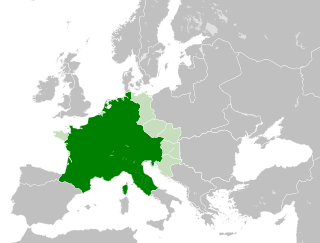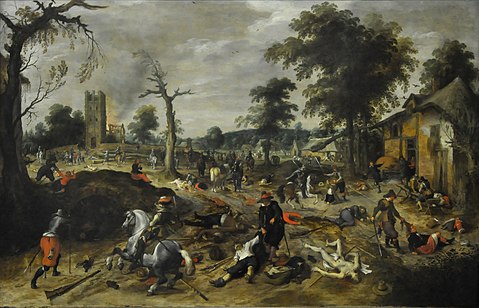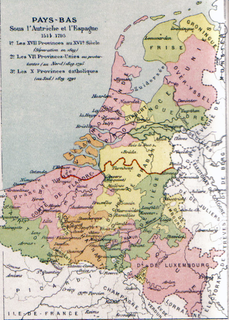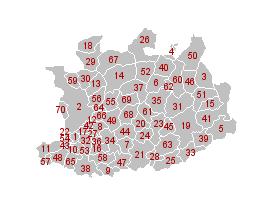
Geel is a city located in the Belgian province of Antwerp, which acquired city status in the 1980s. It comprises Central-Geel which is constituted of 4 old parishes a/o towns: Sint-Amand, Sint-Dimpna, Holven and Elsum. Further on around the center are the parish-towns of Ten Aard (N), Bel (E), Winkelomheide (SE), Stelen, Oosterlo and Zammel (S), Punt (SW) and Larum (W). On December 31, 2016, Geel had a total population of 39,535. The total area is 109.85 km2 (42 sq mi) which gives a population density of 320 inhabitants per km². Geel’s patron saint, the Irish Saint Dymphna, inspired the town’s pioneering de-institutionalized method of care for the mentally ill.

Herentals is a city in the province of Antwerp. The municipality comprises the city of Herentals proper and the towns of Morkhoven and Noorderwijk. On January 1, 2006 Herentals had a total population of 26,071. The total area is 48.56 km2 (18.75 sq mi) which gives a population density of 537 inhabitants per km². Saint-Waldetrudis is the patron saint of the city.

Turnhout is a Belgian municipality located in the Flemish province of Antwerp. The municipality comprises only the city of Turnhout proper. On January 1, 2015, Turnhout had a total population of 42,637. The total area is 56.06 km² which gives a population density of 835.5 inhabitants per km². The agglomeration, however, is much larger, accounting up to 81,473 inhabitants. Turnhout is known for its playing card industry, as it houses the head office of the world's largest manufacturer of playing cards, Cartamundi. Turnhout is also the capital of the administrative district with the same name. The Turnhout city council often promotes the city as "the capital of the Kempen area". This designation is entirely unofficial, since the Kempen area is far larger than the Turnhout district and does not form an administrative unit.

The Nete is a river in northern Belgium, right tributary of the Rupel. It flows through the Belgian province of Antwerp. It is formed in Lier, at the confluence of the rivers Grote Nete and Kleine Nete. It flows through Duffel and joins the river Dijle in Rumst to form the river Rupel. It drains nearly 60% of Antwerp province.
The Iron Rhine or Steel Rhine is a partially nonoperational freight railway connecting the port of Antwerp (Belgium) and Mönchengladbach (Germany) by way of Neerpelt and the Dutch towns of Weert and Roermond.

The Flemish Diamond is the Flemish reference to a network of four metropolitan areas in Belgium, three of which are in the central provinces of Flanders, together with the Brussels Capital Region. It consists of four agglomerations which form the four corners of an abstract diamond shape: Brussels, Ghent, Antwerp and Leuven. Over five million people live in this area, with a population density of about 820 per square kilometre.

The Campine (French) or De Kempen (Dutch) is a natural region situated chiefly in north-eastern Belgium and parts of the south-eastern Netherlands which once consisted mainly of extensive moors, tracts of sandy heath, and wetlands. It encompasses a large northern and eastern portion of Antwerp province and adjacent parts of Limburg in Belgium, as well as portions of the Dutch province of North Brabant and Dutch Limburg around Weert.
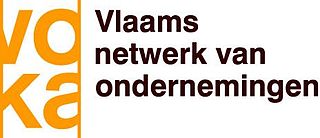
The Vlaams Economisch Verbond or VEV is a Flemish employers' organization and lobbying group. It was founded in 1908, by among others Lieven Gevaert as the Vlaamsch Handelsverbond, to create a Flemish counterpart of the Federation of Belgian Enterprises, and it became the VEV in 1926.
Proost International Book Production is a Belgian manufacturer and supplier for the book publishing industry. It is one of the companies of the printing valley around Turnhout, Belgium. The company operates from 2 manufacturing sites in Belgium, one in Turnhout (Flanders) and one in Fleurus (Wallonia).
Biermans was a Belgian printing company, located in Turnhout, Belgium. It was one of several companies located in the printing valley of Turnhout.
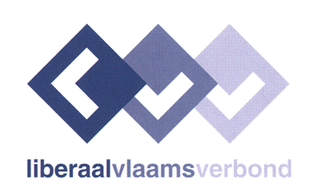
The Liberaal Vlaams Verbond was founded in 1913. From its origin it wanted to promote the Flemish cause and drew attention to social matters, within the Belgian Liberal Party. Together with the Willemsfonds and the Liberaal Vlaams Studentenverbond, it is one of the Flemish liberal organizations.
Camille Paulus is a Belgian lawyer and liberal politician. He was governor of the Belgian province of Antwerp from 1 October 1993 until 30 April 2008.
The Katholieke Hogeschool Kempen was a university college where students could obtain a professional bachelor's degree in several domains. There was also the opportunity to study for a master's degree in engineering in agriculture (bioscience) or an engineering degree in electronics. In 2012 the institution fused with Lessius Mechelen and Lessius Antwerp under a new name: Thomas More University College.
The Campus Blairon is a business incubator, education site, local government site, medical post and a seminar centre located in Turnhout in the campine region of the Antwerp province (Belgium). Both the Artesis Hogeschool Antwerpen and the Katholieke Hogeschool Kempen are located on the Campus.

Herentals is a railway station in Herentals, Antwerp, Belgium. The station opened in 1855 and is located on Line 15 and Line 29.

Turnhout is a railway station in Turnhout, Antwerp, Belgium. The station opened in 1855 and is located on Line 29.

Donk is a township in the municipality of Mol in the province of Antwerp in Belgium. Donk resides at the southern side of the Bocholt–Herentals Canal and is an industrial area, especially in past.

![]()






